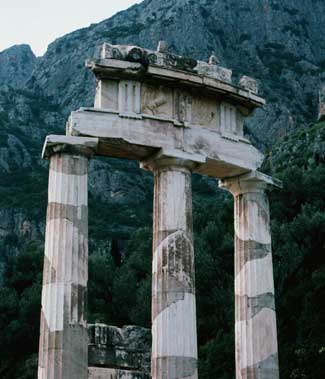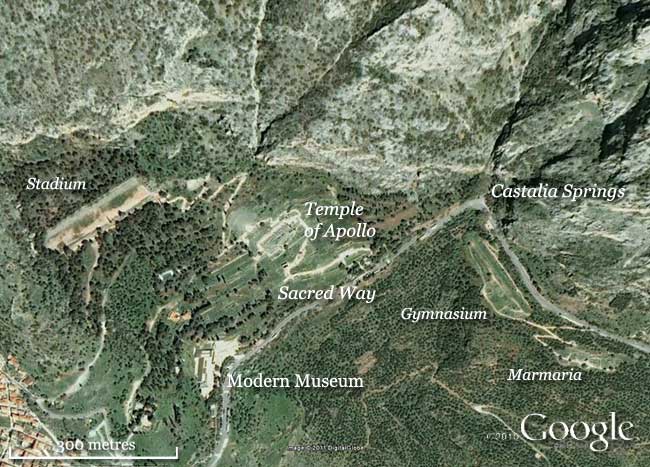
Outside the Sanctuary
The Athena Pronoia Temple (“The Marmaria”)
Just south of the main road leading from Arachova to Delphi is a small sacred terrace. This is the area of the Delphi environs that has yielded the earliest evidence of occupation. In soundings beneath the standing Classical remains, evidence for a Mycenaean cult centre has been inferred from late Bronze Age sherds and artefacts. The first Athena 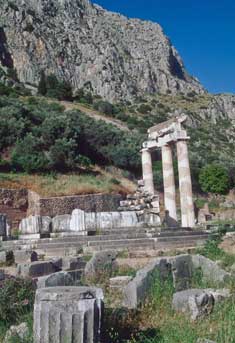 temple was built in the Archaic period and was a small peripheral temple and known as the Athena Pronaia temple, the “Athena-in-front-of-the-temple” (Guardian of the Temple). This temple was destroyed by a rock fall before the time of Herodotus in the fifth century BC, the same miraculous event which routed the Persians from their assault, and replaced by an adjacent temple in the fourth century BC when the area became known as Athena Pronoia (note the vowel change), “Athena Forethought.” Most of the other structures on this terrace are treasury buildings, which were reused as village houses up until 1891 when the village of Delphi was moved. Pausanias describes a statue in front of the later temple of Athena, “which was bigger than the (cult) statue inside” dedicated by the city of Massalia (modern Marseilles). The Treasury of the Massalians was built in 530 BC and was building with two Aeolic columns, in antis, supporting the front porch and made of marble from the island of Paros.
temple was built in the Archaic period and was a small peripheral temple and known as the Athena Pronaia temple, the “Athena-in-front-of-the-temple” (Guardian of the Temple). This temple was destroyed by a rock fall before the time of Herodotus in the fifth century BC, the same miraculous event which routed the Persians from their assault, and replaced by an adjacent temple in the fourth century BC when the area became known as Athena Pronoia (note the vowel change), “Athena Forethought.” Most of the other structures on this terrace are treasury buildings, which were reused as village houses up until 1891 when the village of Delphi was moved. Pausanias describes a statue in front of the later temple of Athena, “which was bigger than the (cult) statue inside” dedicated by the city of Massalia (modern Marseilles). The Treasury of the Massalians was built in 530 BC and was building with two Aeolic columns, in antis, supporting the front porch and made of marble from the island of Paros.
The most notable of the buildings on the Athena Pronoia terrace is the Tholos, for which the terrace gets its nickname of Marmaria. This circular structure made out of Pentellic marble with a circular peripteros of 20 slender Doric columns, was built in the early fourth century BC by the architect Theodorus, who was so proud of it that he wrote a treatise on its construction. The interior was decorated with 10 Corinthian half columns. Surprisingly, Pausanias does not mention this unique building in his brief discussion of the terrace. He describes only four structures, the first in ruins (the old Athena temple), the next empty of statues and offerings
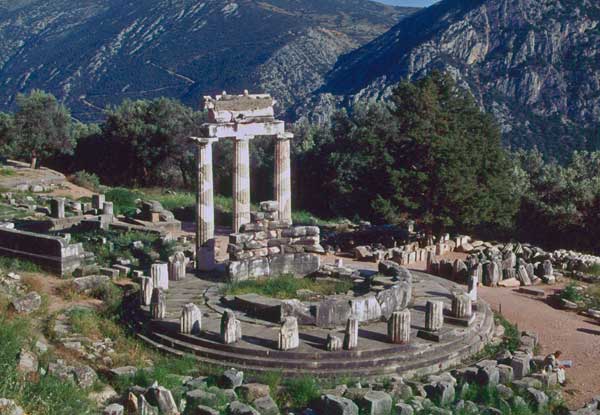
Tholos at the Temple of Athena Pronoia
(perhaps the Tholos), the third had portraits of Roman kings, and the fourth is called the Temple of Athena Foresight.
We do not know what the function of this beautiful structure was but it may have been built to house a statue robbed by the time of Pausanias. In the fifteenth century, Cyriacus of Ancona mistook it for the Temple of Apollo. Three columns and the entablature were re-erected in 1938 and make this one of the most picturesque remains of the ancient site of Delphi.
The Gymnasium
Between the Marmaria and the Castalia Spring, south of the Arachova - Delphi road is the Gymnasium. This two-level complex of athletic building was built in the late Classical/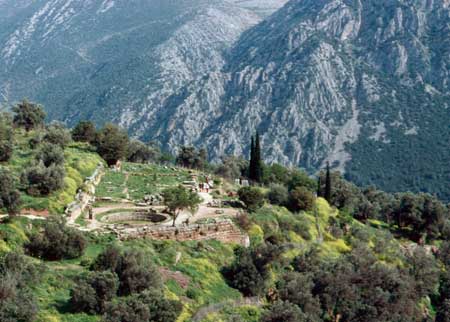 Hellenistic period and rebuilt during the Roman. On the upper level was the xystos or long colonnade where the athletes practiced in bad weather and a parallel track in the open air. On the lower level are the remains of a peristyle court, which served as a palaestra or wrestling ground, which is the most recognizable of the standing remains. A monastery was built into this Palaestra, actually reusing some of the ancient walls. It was moved out when the village was relocated in 1891. Next to the palaestra were a bath complex with a cold plunge and some small tubs built into the back of the terrace. A hot bath was added in the Roman period. In the vicinity, there is a column fragment signed by Byron.
Hellenistic period and rebuilt during the Roman. On the upper level was the xystos or long colonnade where the athletes practiced in bad weather and a parallel track in the open air. On the lower level are the remains of a peristyle court, which served as a palaestra or wrestling ground, which is the most recognizable of the standing remains. A monastery was built into this Palaestra, actually reusing some of the ancient walls. It was moved out when the village was relocated in 1891. Next to the palaestra were a bath complex with a cold plunge and some small tubs built into the back of the terrace. A hot bath was added in the Roman period. In the vicinity, there is a column fragment signed by Byron.

